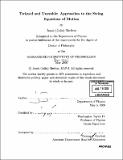| dc.contributor.advisor | Washington Taylor, IV. | en_US |
| dc.contributor.author | Shelton, Jessie | en_US |
| dc.contributor.other | Massachusetts Institute of Technology. Dept. of Physics. | en_US |
| dc.date.accessioned | 2007-03-12T17:56:10Z | |
| dc.date.available | 2007-03-12T17:56:10Z | |
| dc.date.copyright | 2006 | en_US |
| dc.date.issued | 2006 | en_US |
| dc.identifier.uri | http://hdl.handle.net/1721.1/36813 | |
| dc.description | Thesis (Ph. D.)--Massachusetts Institute of Technology, Dept. of Physics, 2006. | en_US |
| dc.description | Includes bibliographical references (p. 183-197). | en_US |
| dc.description.abstract | In this thesis we will explore three approaches to aspects of the fundamental structure of string theory. We first provide a brief review of perturbative string theory, and briefly discuss how each of the three topics to be discussed in the body of this thesis depart from this starting point. We then study the open string one-loop tadpole diagram in Witten cubic open string field theory. We compute this diagram both analytically and numerically and study the divergences arising from the collective behavior of open string fields in the short-distance region of the diagram. We demonstrate that this region of the diagram encodes information about the linearized Einstein equation describing the shift in the closed string fields in reaction to the D-brane supporting the open strings. We also show that the manner in which this information is encoded is somewhat singular, and comment on the implications for the quantum consistency of open bosonic string field theory. We next compute the closed string radiation from a decaying D-brane in type II string theory. The calculation is made possible by noting that the integrals involved in the requisite disk one-point functions reduce to integrals over the group manifold of a product of unitary groups. | en_US |
| dc.description.abstract | (cont.) We find that the total number and energy of strings radiated during the decay process diverges for D-branes of small enough dimension, in precise analogy to the bosonic case. Finally, we investigate a simple class of type II string compactifications which incorporate nongeometric "fluxes" in addition to "geometric flux" and the usual H-field and R-R fluxes. We develop T-duality rules for NS-NS geometric and nongeometric fluxes, which we use to construct a superpotential for the dimensionally reduced four-dimensional theory. The resulting structure is invariant under T-duality, so that the distribution of vacua in the IIA and IIB theories is identical when nongeometric fluxes are included. | en_US |
| dc.description.statementofresponsibility | by Jessie (Julia) Shelton. | en_US |
| dc.format.extent | 197 p. | en_US |
| dc.language.iso | eng | en_US |
| dc.publisher | Massachusetts Institute of Technology | en_US |
| dc.rights | M.I.T. theses are protected by copyright. They may be viewed from this source for any purpose, but reproduction or distribution in any format is prohibited without written permission. See provided URL for inquiries about permission. | en_US |
| dc.rights.uri | http://dspace.mit.edu/handle/1721.1/7582 | |
| dc.subject | Physics. | en_US |
| dc.title | Twisted and unstable : approaches to the string equations of motion | en_US |
| dc.type | Thesis | en_US |
| dc.description.degree | Ph.D. | en_US |
| dc.contributor.department | Massachusetts Institute of Technology. Department of Physics | |
| dc.identifier.oclc | 81964860 | en_US |
